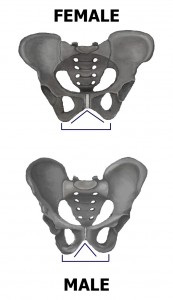Your saddle will either be your best friend or your worst enemy when you are spending hours in the saddle on your tour.
Every rider has a different physical shape, and the saddle should be selected based on that shape. The ideal for selecting a saddle is to go through a fitting process at your local bike shop. If, like Jane, you don’t have access to this service, you will need to select and fit your own saddle.
Rider Anatomy
Your ‘sit bones’ (ischial tuberosities), are the two segments of bone that protrude downwards from your pelvis. On a bicycle saddle these sit bones are the ones that take most of your weight and cause most of the pain after a long time in the saddle. There are significant anatomical differences between the male and female pelvis – see image – notably the width of the pelvis and the angle of the sit bones.
As a generalisation, female cyclists need a wider, but shorter, saddle than male cyclists to take into account these differences in anatomy. Obviously there is a great deal of variation in physical form between riders and that is why careful consideration needs to be given to saddle selection and fit.
As always, Sheldon Brown has a brilliant article on saddle selection.
Saddle Soreness
Saddle soreness can be attributed to both the shape of the saddle and it’s position on the bike. There are a few adjustments you can make to see if it eases the pain:
- adjust the angle of the saddle – normal position is horizontal – a few degrees in either direction could ease some discomfort;
- adjust the horizontal position of the saddle, make sure you don’t shift it too far forward or backward as this can impact on pedalling efficiency and create problems for your knees; or,
- adjust the seat stem and/or handlebar heights to change your riding position and the pressure points on your seat.
You should not add a layer of additional padding to your saddle. Extra padding will only serve to exacerbate chafing and, while it will provide temporary relief from pressure-related soreness, within a short while that pain will return as it is the shape of the saddle (and it’s skeleton) rather than the surface that is causing the problem.
Training can help you to develop ‘tougher’ sit bones, but is no substitute for a properly fitted saddle. With any saddle there is a break-in period where both the saddle and you get used to each other. If after a few hundred kilometers (one thousand for a leather saddle), it’s still not working, and you’ve adjusted the position of the saddle as discussed above, you probably need to try a different model.
What type of saddle should I choose?
Saddles come in all shapes and sizes, and the best saddle for you is the one that is comfortable, and you can ride in all day long. In the absence of a professional fitting service, trial and error might be your only option for finding out.
Most touring cyclists seem to swear by the leather saddle, particularly those produced by Brooks of England, as they mold to the cyclists particular shape over time. On the advice of other touring cyclists, Jane decided to purchase one of these saddles (the B-17s model, tailored to female cyclists) and, while the break-in period was difficult on both parties, the saddle has become quite comfortable and promises to be more so as the saddle continues to mold to Jane’s shape.
